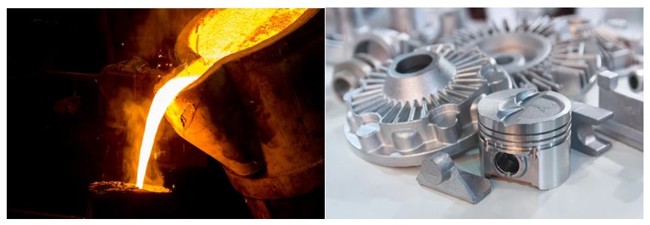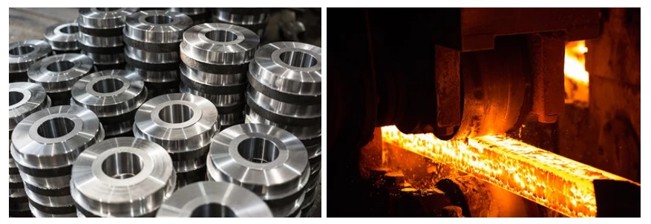In a variety of industries, casting and forging are popular methods of creating components and parts. In spite of this, the processes are very different from one another, and the products produced by each have different characteristics. As a leading industrial manufacturing and engineering company specialising in metal forming and fabrication, we are here to clarify casting from forging and help you decide which is best for your project.
What is casting?
The process of casting involves pouring molten metal into a mould and then letting it cool and harden before removing it from the mould. This process is ideal for mass-producing parts and creating identical products using the same mould.
The casting comes in various forms. When liquid metal is forced into a die instead of a mould and kept there by pressure until it hardens, this is called die-casting. The process is known for its support for high-speed applications. Mould casting on permanent moulds is the process of pouring molten metal into a metal mould, either using gravity or a vacuum. Permanent mould castings can produce stronger castings than die casting, but they can be hard to remove from the final product. Thus, semi-permanent mould castings are also available. With these moulds, the cores can be expended, making the removal process less difficult and more affordable.

Last but not least, sand casting is a method of casting that involves pressing a pattern into a fine mixture of sand. Moulds are formed for the molten metal to be poured into. Despite its slow speed, this process is more economical than other methods of casting. For large-scale metal fabrications and intricate designs, this is a good choice.
The advantages of casting include:
- Casting weight has no real upper limit
- Castings can be made in a wide range of materials
- Custom alloys are more difficult to produce in forgings as they remain solid, whereas, with casting, alloys such as Chrome, Nickel and Moly can be added during the melting process.
- The cost of tooling is often less than that of forge dies
- The production runs need to be smaller
- The complexity/complexity of the parts is no problem
What is forging?
In forging, metal is shaped by compressive force. Hammers or dies are used to shape metal until the desired shape is achieved. Through the process of forging, the metal becomes deformed and shaped, which results in a continuous grain flow that allows it to remain strong. Furthermore, the removal of defects, inclusions and porosity from the product is an ancillary benefit of this unique grain flow.

In addition to its low cost, forging is also beneficial for medium and long production runs. By careful design of forging tools, it is possible to manufacture products at relatively high speeds with minimal downtime.
When forging takes place at room temperature, it is referred to as cold forging. The forging process can also be undertaken with the metal heated above room temperature to temperatures below that of recrystallization, which is called warm forging. In the hot forging process, metals are heated to their recrystallization temperature, which differs for each material. With blacksmiths using forging centuries ago, forging is amongst the oldest types of fabrication.
Forging offers the following benefits:
- It tends to be tougher than other manufacturing methods.
- More impact-resistant than castings.
- Since forging is not porous, shrinkage, cavities, or caused by cold pour, these issues do not occur.
- Forgings have a tight grain structure, making them mechanically strong. Components with high strength require fewer expensive alloys.
- It is believed that the tight grain structure imparts good wear resistance without the need to produce products that are "super hard". For example, we found that wear/wash on HRC 38-42 forged grinder inserts was similar to that on cast HRC 46-50 grinder inserts. The difference is that HRC 46-50 castings cannot handle high-impact grinding due to their ductility.
Casting vs. Forging: What's the Difference?
Castings produce metal products with relatively low strength, while forgings create metal products with higher strength and hardness. Forged metals have a lower likelihood of shattering when they come into contact with different objects.
Omnidex Metal Castings Services
During forging, a change of shape is forced into the metal, either by pressing or hammering. Consequently, the metal gains strength. Contrary to other fabrication methods, the forging process stretches the metal grain, aligning it in one direction rather than causing it to be randomly oriented. However, forging can only be done within size limitations.
Forging entails a greater degree of difficulty because the metal is kept in a solid state, unlike casting. Metal sizes and thickness are restricted by forging because it is more difficult to change the shape of the metal. The larger the metal section, the more difficult it is to forge.
On the other hand, casting allows more complex shapes to be produced because molten metal flows into a mould or die cavity. It is possible to cast products of up to 200 tons of weight out of almost any material. Casting is usually much cheaper than forging. Each casting method has its own advantages and disadvantages, so the most suitable method will depend on the application.
Metal Casting Vs. Metal Forging: 5 Things to Consider
1. Size & weight of the Finished Product
2. Design of the Component
When it comes to designing a part for either casting or forging, some characteristics to evaluate include:
- Part complexity
- Tolerances
- Grain structure
- Structure integrity
3. Alloy Selection
A key consideration when it comes to castings vs forgings is the availability of alloys to use. In forging, the components are made from billets produced at a steel mill. These mills generally only manufacture a specific number of grades and alloys.
In comparison, castings are melted and poured at the foundry making special alloy costs more manageable.
4. Internal Strength of the Component
Deciding between the two processes depends upon the; forgings will typically be stronger in a particular direction, but castings are stronger uniformly throughout.
When the application involves frequent impacts, a forging will retain its shape longer. If a uniformly strong component is needed for the application, a casting will perform better.
5. Cost of Castings vs. Forgings
The price of castings vs. forgings is dependent upon multiple variables. Each of the processes is less expensive in some cases and more expensive in others. Various factors that play into the price of a part are:
- Production volume
- Alloy
- Shape complexity
- The specific process of casting or forging
- Specifications including required testing
Summary
In this guide, we focus on the fundamental differences between casting and forging.
When it comes to metal components, there is no such thing as a size fits all approach. The best choice for you may depend on the specific metal component, its purpose, and its overall needs. If you need particular metals, either casting or forging may be the best. Consultation with manufacturers is the best way to determine which process is right for you.
Get in touch with us or send a quote request if you think metal casting may be the right solution for your application.





Hard hat mounted air curtain adds layer of protection
Something similar was used by miners decades ago!